Except for a couple of unseasonably warm days last week, there’s no question fall has arrived.
The mornings are crisp and clear, and as the sun tracks lower in the sky, the sunlight has a warmer glow than the harsh overhead sun in mid-summer.
Native Garden
Although most of our California native blooming plants are no longer in flower it doesn’t mean the gardens look desolate.
Our reliable California Fuchsias (Epilobium canum) are still blooming, and most days we find hummingbirds nectaring among the flowers.
All around the hillsides we’re starting to see the bright red berries of our native hairy honeysuckle (Lonicera hispidula).
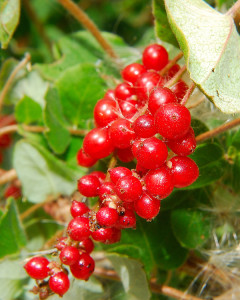
Since we added bees to the farm, we’ve noticed many more berries on the native honeysuckle (Lonicera hispidula)
It’s quite surprising to see where some of these vines end up, often many feet overhead as they twine through the surrounding oak trees.
In the irrigated native garden near the house, we’ve been pleasantly surprised this fall by the native Sticky Monkeyflower (Diplacus aurantiacus ssp. aurantiacus) that is producing a second flush of bloom.
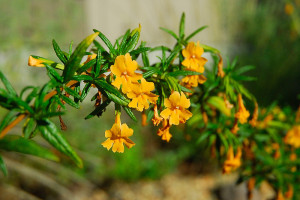
We had not expected the Monkeyflower (Diplacus aurantiacus) to bloom this much so late in the season.
We have a number of these plants growing wild on the property that don’t receive any supplemental water. Those plants bloom once, in late spring, and then they’re done for the season. When we planted the new native garden in front of the house we added this lone specimen, which does receive occasional water, at least this season while the garden gets established. Clearly it seems to be appreciating the little water it’s receiving, and is blooming almost as much as it did in the spring.
Remarkably, some of the native sages are still producing some flowers too.
They’re not flowering as prolifically as in the spring, but we’re still seeing a few on Salvia ‘Allen Chickering’, and ‘Winnifred Gilman’.
I think I may have a new favorite native sage though, the creeping sage, Salvia sonomensis ‘Fremont’s Carpet’.
I planted a few this spring to help hide a rather ugly low mixed block and stone wall. My hope was that as they grew and spread the branches would spill over the edges of the wall, and draw the eye away from what I consider to be something of an eyesore. Honestly, I couldn’t be happier with how these plants are performing even in their first season, and they’re growing exactly how I hoped they would. They’re even producing the occasional flower stalk, in October!

As this is the first season in the ground for this Salvia, we’re really looking forward to seeing the blooms next spring
The native plant I’m happiest with this month though is actually our native deer grass (Muhlenbergia rigens).
These grasses have become quite large even in their first season, but because of the scale of the surrounding woodland, they don’t look out of place.
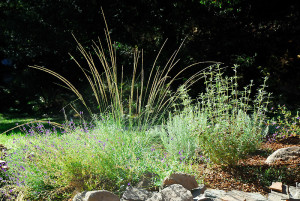
Due to its height, and movement in the garden, Muhlenbergia rigens has brought a lot more visual interest to this part of the garden
I love how the grasses move in a light fall breeze, and the golden glow in the mornings as they catch the morning sun.
It’s been very easy to grow, the deer ignore it, and I can envision planting quite a lot more of it here in some of the more open areas away from the house.
Kitchen Garden
Most of the excitement is in the kitchen garden in October. Although we’ve been harvesting something all season, this is the time of year when the kitchen gets really busy, as we scramble to harvest and store the last of the summer’s bounty before the rains return.
Believe it or not, the eggplants are still producing!
It has been a phenomenal season for eggplant here, to the point that, quite honestly, I’m a little burned out on it. There’s really only so much Baba Ghannouj a person can eat in one season!
The cucumbers have had a reasonably good season, when they’re not being devoured by woodland creatures. For a while, during the warmest part of summer, fruit production slowed.
Although the leaves are starting to decay, the vines are still pushing a last modest flush of fruit, so we may be able to harvest a few more before the season ends.
The greens have been doing well, and we seem to have an endless supply of kale and red-veined sorrel at the moment.
It’s not all success though. Beans, this year, for the most part, were a near total disaster.
They started out beautifully this season, and in August were doing fairly well, but then the voles escalated the rate of destruction in the bean beds.
Every time I’d trap one vole, another seemed to move in. The carnage was infuriating. This is the first year that our bush bean harvest has been so meager.

…and this is why. The leaf was concealing a vole tunnel entrance…the sneaky rodent was trying to hide the front door!
The pole beans fared somewhat better, but not much. Of those, our best harvest was of the heirloom romano-type Spanish Musica beans.
These beans have a wonderfully nutty flavor for a bean, and are one of our all time favorites. Next year though, we need to devise a way of protecting all the beans from the wretched rodents.
October, though, is really all about winter squash, tomatoes, and peppers.

Clockwise from left, Jarrahdale, Boston Marrow, Galeux d’Eysines, Waltham Butternut, and Pink Banana (center)
After last year’s Great Heirloom Squash Experiment, this year we scaled back the number of varieties we grew to some of those that performed the best. We also planted fewer plants, and spaced them further apart to discourage the voles. It seemed to help, although we still had a few losses this season, but overall the squash has done quite well this season, with the exception of Marina di Chioggia, which we are unlikely to plant again as it hasn’t performed well for us two years in a row.
I’ll get more into the tomatoes this season during our tomato review post next week, when we summarize our experience with grafting and production this season, but suffice it to say that this season has been a tremendous improvement in yields over the last two seasons.
Between grafting the tomato plants, and a significantly warmer and sunnier season this year, we’re finally back on track with tomato production.
However, this has also been our best year here for peppers! At the moment we seem to have them in almost every color imaginable.
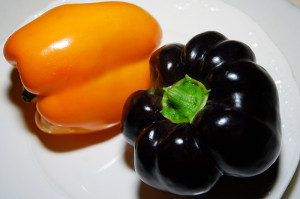
These peppers look quite festive for Halloween. ‘California Golden Wonder’ (left), and ‘Purple Beauty’ (right)
Our favorite producers this year, other than the Padrón peppers, has been Corno di Toro.
The only disappointment is that some of the Corno di Toro were supposed to be red, but turned out to be yellow, but we’re not complaining. These peppers have been so prolific that the weight of the fruits pulled over a number of the plants. Next year we’ll need to stake them.
Yesterday I picked almost 20 lbs of peppers, so for the remainder of today you’ll find me in the kitchen marinating, pickling, and canning at least a peck of rainbow-colored peppers!
Now that some of the summer harvest is winding down, it’s also time to get some of the garden beds prepared for our next planting of garlic and onions. Hopefully by then the rains will return, and then it will be time to start transplanting all the native plants we’re holding in the greenhouse. First though…it’s time to work on that peck of pickled peppers!


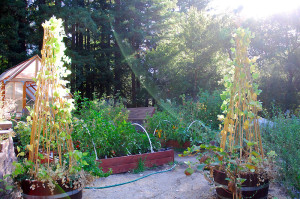
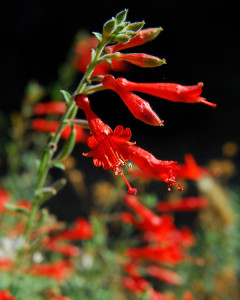
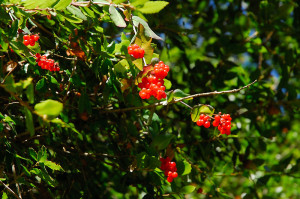
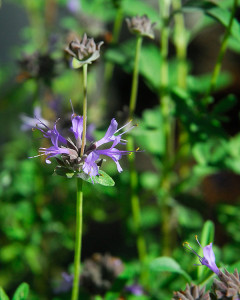
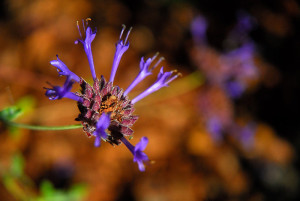



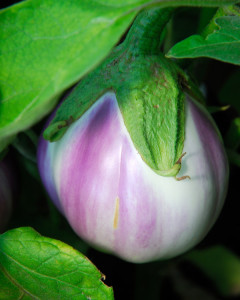
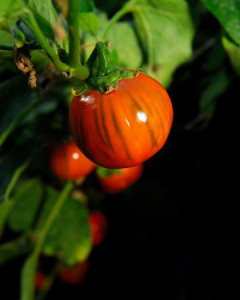

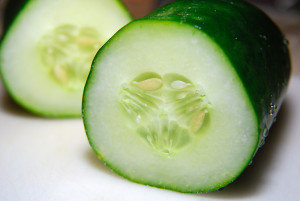
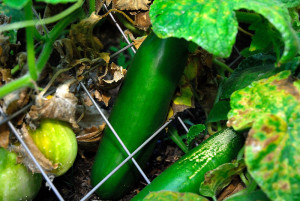

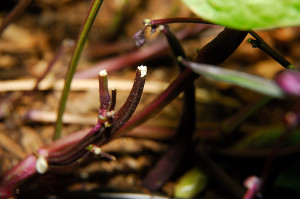



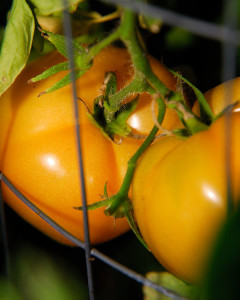
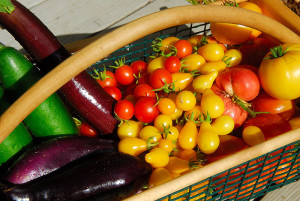
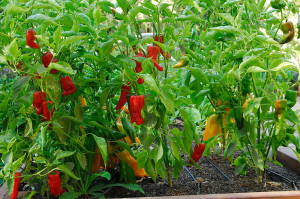

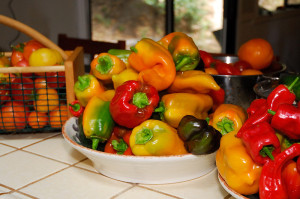







Beautiful harvest! Next year is going to be my year for a fantastic edibles garden — I mean it this time!
That phrase sounds familiar, I think I say that every year. Between voles, gophers, and their ilk, whether the edible garden turns out fantastic seems to be largely up to them! 😛
What an impressive harvest! And some beautifully colored eggplant!
Don’t get me started on voles. I tried a couple different types of traps and couldn’t catch a solitary one. They’ve decimated my garden this year. Finally, after repeated applications of castor oil, they seem to be moving on (crossing fingers).
Voles can be tricky to trap. I’ve tried the inverted piece of gutter trick, where you set it over the tunnel entrance, with a trap placed on each side. I’ve had variable success with that. The trouble is finding the tunnel that’s most active. There were so many holes in the bean bed, it looked like Swiss cheese. I was so frustrated at one point I placed clusters of 3 or 4 mouse traps around each hole. Not very efficient (in the use of traps), but it did work!
I must try those Turkish Eggplants and Spanish Musica beans! It sounds like Salvia sonomensis is just what I need for a problem spot, too. As always, your posts are a treat to read.
The Turkish Orange Eggplants certainly make for an interesting conversation piece in the garden, but their flavor wasn’t particularly exciting, and sometimes quite bitter. For use in the kitchen, Japanese Long Purple, and Little Fingers, were far superior. The Musica beans though were great, and I’ll definitely be planting them again.
Voles are such nasty little things! I hate to admit it, but our two garden kitties have done a wonderful job reducing our vole population. (So much for our backyard wildlife habitat certification–it’s probably being revoked!)
Our beans didn’t produce well this year, either–and I haven’t figured out why. However, the peppers and cucumbers are so prolific that I’m at a loss what to do with them all. I keep trying new experiments and searching for recipes! 😉
Your squash is gorgeous–and you’re growing some of my favorite tomatoes. It seems that your Corno di Toro peppers ended up being ‘Giallo’ rather than ‘Rosso.’ Still–they’re lovely!
Your fall harvest is much more plentiful than ours…most is done, but the fall crops are in, so we should soon have lettuce, kale, and chard from the garden.
Happy harvesting! Enjoy!
We’ve gone back and forth on having a farm cat to help with the rodents. For now we’re trying to minimize hiding places, and encourage the raptors to hunt here, but most days it feels like a losing battle 🙁
I didn’t mind the yellow Corno di Toro, but next season I would like a few red ones too! The peppers look so pretty in the jars I canned last night.
I don’t think I’ve ever seen an orange Eggplant. Wow, you sure have a plentiful collection of Peppers. I can think of so many dishes that would taste and look great with all those colors! Very impressive.
I was very attracted to the uniqueness of the Turkish Orange eggplant. I only planted the one, but it actually produced very well.
I’ve been marinating and pickling peppers, and hopefully will finish up the last batch today. I preserved half of them in white wine vinegar and oil, and the other half I’m pickling with ginger and garlic. The rest we harvest for the season I think we’ll just freeze. It will be so nice to keep enjoying these all through the winter!
Well, while everyone is gushing about the veggies, let me just say how beautiful the native plant garden is – the fragrance of the sage, the stunning monkey flower… And not too much trouble with pests in that part of the garden either.
Then again, pickled peppers do sound great!
I loved the light rain we had yesterday. The sage smells divine right after a rain. I know some don’t like the aroma of our native sages, but I love it, which is probably why I planted so much near the front door! I’ve had to do a little editing along the way, as the deer have nibbled a few things they shouldn’t, but overall this part of the garden is doing really well.
Your variety of eggplant has caught my eye, Clare… beautiful! Are they just as delicious?
I would plant all of the varieties, except Turkish Orange, again next year. I’ve really enjoyed the smaller size of these little heirloom varieties. ‘Little Fingers’ has been great to throw in a stir fry, and the larger Listada de Gandia, Rosa Bianca, and Long Purple were fabulous grilled, or turned into Baba Ghannouj. They’ve all been flavorful, without being bitter too. Turkish Orange did well, but had more of a tendency to be bitter. It does look stunning in the garden though.
Clare it’s so good to see your Fall garden, both natives and produce. I love the color of the Jarrahdale squash. I find I’m drawn to none traditional fall colors.
Your Cleveland sage is still blooming? How nice! I wondered all summer if I should clip off the seed heads of mine and now I’m thinking that maybe that might encourage bloom now. I didn’t and have been enjoying the look of them but next summer might try something different. I have Pozo Blue, too!
And my deer grass has finally become full grown, I think, and is a good three feet by three feet in an airy sort of way. Love your photo of its ‘bloom’
Last year I vowed to plant a monkey flower next to each Pozo,…the look was so fine,…this year I will! No one knows these in my area and there are five on markdown that I have my eye on.
I’m surprised how much the sages have bloomed this year, and the hummingbirds seem to appreciate the few late season blooms too. Some of the Allen Chickering sage stopped blooming in the heat of the summer, but then started to produce a few more flowers for fall. I really love Pozo Blue too. I planted that for the first time this spring. It was very prolific in bloom, and seemed to bloom for a longer period than Allen too. What’s really struck me about the new native garden area though is how ‘mature’ it looks already. It’s difficult to believe that area was only planted this spring! I think you should rescue those markdowns! 😉
Clare you know I love your natives especially all those salvias and fuchsias I can’t grow…and look at that bounty…I finally finished my eggplants, but the beans are under cover with the salad greens and carrots so I can extend the season….
Growing under cover is something we do a lot here too. In the summer shade cover helps us grow lettuce even during warm weather, and then in the winter the row covers help to raised the temperature in the beds a few degrees to extend our season. Unfortunately, it also tends to give our wretched voles somewhere to hide too 🙁
I love how your native garden is looking! Those grasses and blooms are really stunning. My goodness you have a prolific harvest! Our eggplant finally started producing and now it is going to town. A little cooler, less humid weather seemed to be the trick. I am impressed with all your colors! It really all looks very scrumptious! We are constantly battling with the voles but so far they haven’t made it to the kitchen garden.
This was the first year the voles found the kitchen garden. I think that before we installed the last few raised beds, there was enough open area to discourage them. This summer though they plowed through the bean beds. I may try growing more pole beans rather than bush varieties next year, to keep the ground cover down, and give them less foliar growth to hide under. I hate being outsmarted by rodents! 😛
I love that crawling salvia. I’m going to check it out and see if it would grow here in southern Canada, even as an annual?
Salvia sonomensis usually grows in USDA zones 8-10. In warmer inland locations it needs partial shade, but here on the coast it’s been doing great in full sun. These plants have grown between 4′-6′ in a single season. I can’t wait to see how large they are by next spring!